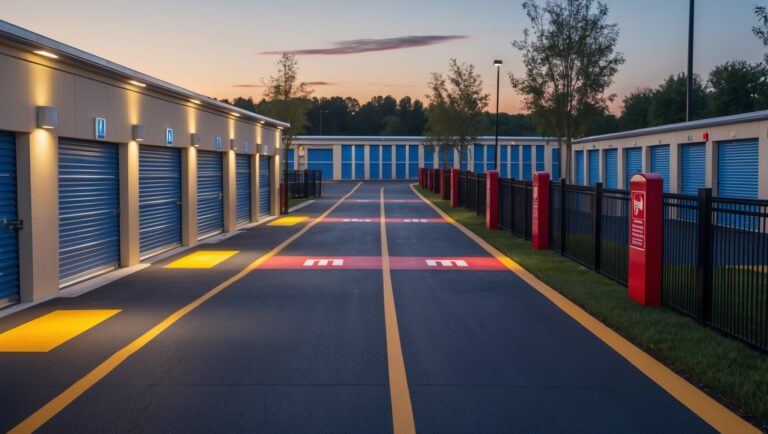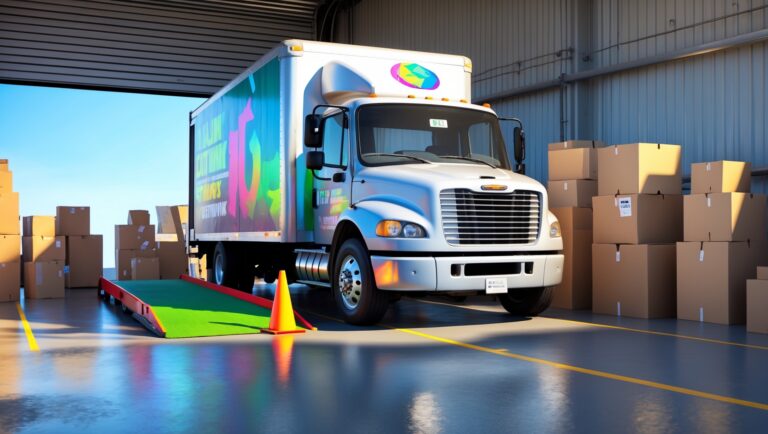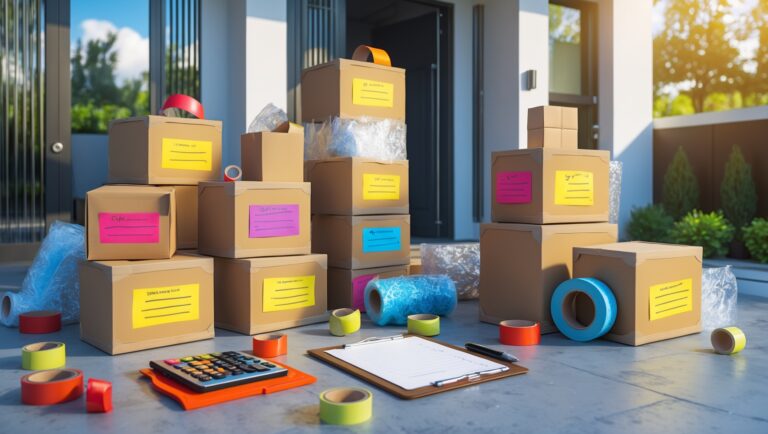Self-Storage Facility Lighting Solutions: Energy Savings, Safety, and Upgrades
Introduction: Why Lighting Matters in Self-Storage Facilities
Lighting is often overlooked in the self-storage industry, yet it directly impacts security, operational costs, customer satisfaction, and the overall value of your property. Whether you manage a small independent facility or a multi-building complex, your lighting choices influence everything from utility bills to tenant retention. Inadequate or outdated lighting can create safety hazards, encourage vandalism or theft, and leave a poor impression on potential customers. Conversely, a well-designed, energy-efficient lighting system can reduce expenses, deter trespassers, and elevate your facility’s professional image. This guide explores the latest lighting solutions tailored for self-storage operations, from basic upgrades to advanced smart systems. We’ll cover the business case for lighting improvements, safety and compliance best practices, a breakdown of available technologies, and a step-by-step approach to implementing cost-effective lighting upgrades. Whether your goal is to retrofit an aging property or plan a new build, you’ll find actionable insights to illuminate your path to better facility management.
The Business Case for Upgrading Facility Lighting
Reducing Operational Costs
Lighting can account for up to 30% of a self-storage facility’s electricity usage. Traditional fixtures like metal halide or fluorescent tubes are not only inefficient but also require frequent maintenance. Upgrading to LED systems can yield immediate savings—modern LED fixtures use up to 75% less energy and last 3-5 times longer than older technologies. Reduced bulb replacements mean lower labor costs and less disruption.
Enhancing Security and Reducing Liability
Poorly lit areas are magnets for break-ins, vandalism, and accidents. Bright, uniform lighting in drive aisles, entry points, and walkways discourages criminal activity and helps customers feel safer. This not only lowers the risk of theft but also minimizes your liability for accidents on the property. Well-lit CCTV coverage zones also improve the effectiveness of your surveillance system.
Boosting Tenant Satisfaction and Occupancy
Customers expect clean, safe, and well-lit facilities. Bright exteriors and illuminated units make your property more inviting at night, leading to positive reviews and better word-of-mouth. Improved lighting can also support 24/7 access hours, expanding your potential tenant base.
Key Lighting Zones in Self-Storage Facilities
- Entrance Gates and Keypads: Clear, glare-free lighting improves security and makes keypad use easier after dark.
- Drive Aisles and Parking Areas: Uniform, shadow-free lighting reduces trip hazards and supports vehicle navigation.
- Exterior Walls and Perimeter Fencing: Bright lighting deters unauthorized access and supports surveillance cameras.
- Interior Hallways: For climate-controlled or indoor-access units, motion-activated lighting enhances visibility and energy savings.
- Emergency Exits and Stairwells: Exit signs and path lighting must meet safety codes and support safe evacuation.
Lighting Technologies: What’s Available?
Legacy Lighting Systems
- Fluorescent Tubes (T12, T8): Common in older buildings, but inefficient and contain mercury.
- Metal Halide and High-Pressure Sodium: Bright but expensive to operate, slow warm-up, and poor color rendering.
Modern Lighting Solutions
- LED Fixtures: The gold standard for energy efficiency, durability, and color quality. Available in a wide range of designs for indoor and outdoor use.
- Solar-Powered Lighting: Ideal for remote fencing or areas without existing wiring. Reduces installation costs and utility dependency.
- Smart Lighting Controls: Motion sensors, photocells, timers, and remote monitoring systems help optimize usage and further reduce energy waste.
Compliance, Codes, and Best Practices
Understanding Local Lighting Requirements
Most municipalities have ordinances governing exterior lighting, including required light levels, shielding to prevent light pollution, and emergency exit illumination. Consult building codes and local regulations before planning upgrades. Key standards to consider:
- Illuminance Levels: Common standards call for 1-2 foot-candles at entry points and 0.2-0.5 foot-candles in drive aisles.
- Dark Sky Compliance: Use cutoff fixtures to minimize glare and prevent light spillover onto neighboring properties.
- ADA and Safety Codes: Ensure that all public areas, especially entrances and exits, are accessible and safely lit.
Maintenance and Inspection Protocols
Regular maintenance is crucial for ensuring lighting remains effective and compliant. Develop a monthly inspection checklist:
- Check for burnt-out bulbs or flickering fixtures.
- Clean lenses and housings to remove dust and cobwebs.
- Test motion sensors and photocells for correct operation.
- Inspect wiring and mounting hardware for damage.
Step-by-Step: Planning and Executing a Lighting Upgrade
1. Conduct a Lighting Audit
Walk your property after dark. Note areas with poor illumination, shadows, or light pollution. Record fixture types, wattages, and condition. Consider hiring a professional lighting contractor for a photometric analysis if you’re planning a major upgrade.
2. Set Objectives and Prioritize Zones
Identify your primary goals: reducing energy costs, improving safety, supporting 24/7 access, or meeting new codes. Prioritize high-traffic and high-risk areas for immediate attention, such as entry gates and drive aisles.
3. Choose the Right Fixtures and Controls
- LED Retrofit Kits: Cost-effective for updating existing fixtures without full replacement.
- Full LED Replacements: Best for outdated or failing fixtures. Choose models rated for outdoor use and wide temperature ranges.
- Motion Sensors and Photocells: Automate lighting based on occupancy and daylight, maximizing savings.
- Smart Controls: Centralized systems allow remote monitoring, scheduling, and dimming via smartphone or computer.
4. Calculate ROI and Seek Incentives
Estimate potential savings using manufacturer energy calculators or utility-provided tools. Factor in reduced maintenance and longer fixture lifespan. Check for local, state, or utility rebates—many programs offer incentives for upgrading to LED or installing smart controls.
5. Plan Installation and Minimize Disruption
- Schedule work during off-peak hours to limit customer inconvenience.
- Clearly mark work zones and notify tenants in advance.
- Coordinate with electricians familiar with exterior and commercial lighting systems.
6. Document and Train
Keep detailed records of fixture locations, model numbers, and installation dates. Train staff to identify and report issues such as failed bulbs, vandalism, or sensor malfunctions. Include lighting checks in your routine property walk-throughs.
Lighting Features That Add Value
1. Motion-Activated Lighting
Motion sensors reduce energy consumption by dimming or shutting off lights in unoccupied areas. They also startle would-be trespassers and help tenants feel safer when moving through the property after hours. Adjust sensor sensitivity and timing to avoid nuisance activations.
2. Color Temperature and Light Quality
Choose LED fixtures with a color temperature between 4000K–5000K (neutral to cool white) for outdoor areas—this maximizes visibility and color accuracy for security cameras. For interior corridors, a warmer light (3000K–4000K) may be more comfortable for customers.
3. Emergency and Backup Lighting
Install battery-backed emergency lights in hallways, stairwells, and exit routes. Test regularly to ensure compliance with fire and safety codes. Mark all exit doors with illuminated signs visible in darkness or smoke.
4. Solar and Low-Voltage Options
Solar bollards or wall packs can light remote corners without expensive trenching or wiring. Low-voltage LED strip lighting is ideal for indoor hallways, reducing installation costs and fire risk.
Case Study: Midwestern Mini Storage LED Retrofit
Midwestern Mini Storage, an 80,000-square-foot facility with six drive-up buildings, faced rising utility costs and tenant complaints about dim lighting. Management conducted a lighting audit, discovering that many fixtures were outdated metal halides and half were non-functional. After consulting with an energy services provider, they upgraded all exterior fixtures to commercial-grade LEDs with integrated motion sensors and smart photocells.
- Results: Electricity usage for lighting dropped by 68%.
- Maintenance calls for bulb replacements fell by 90% in the first year.
- Insurance premiums decreased after the insurer reviewed improved security lighting.
- Tenant surveys showed a 25% increase in satisfaction regarding facility safety.
The project paid for itself in 18 months, thanks to utility rebates and operational savings.
Practical Tips for Ongoing Lighting Maintenance
- Walk the property after sunset monthly to spot dark zones or malfunctioning fixtures.
- Clean fixture lenses every six months to maintain brightness.
- Check motion sensor coverage and timings quarterly—adjust as trees grow or layouts change.
- Stock spare drivers and LED modules for quick replacement.
- Test emergency lighting and exit signs in accordance with local fire codes.
Conclusion: Lighting as a Competitive Advantage
Facility lighting is more than a utility expense—it’s a strategic asset that affects every aspect of your self-storage business. Upgrading to modern, energy-efficient lighting pays dividends in reduced costs, improved safety, and enhanced customer loyalty. With today’s LED and smart control technologies, substantial improvements are achievable without a full-scale renovation. A well-lit property stands out in online listings, earns positive reviews, and sends a clear message of professionalism and care. By treating lighting as an ongoing investment—regularly auditing, maintaining, and upgrading systems—you not only protect your property but also create an environment where tenants feel secure and valued. As the industry evolves, facilities that prioritize smart, sustainable lighting will reap the rewards of lower expenses, higher occupancy, and a robust reputation in their market. Take the next step: audit your lighting today, explore available incentives, and illuminate the path to a brighter, more profitable future for your storage business.






